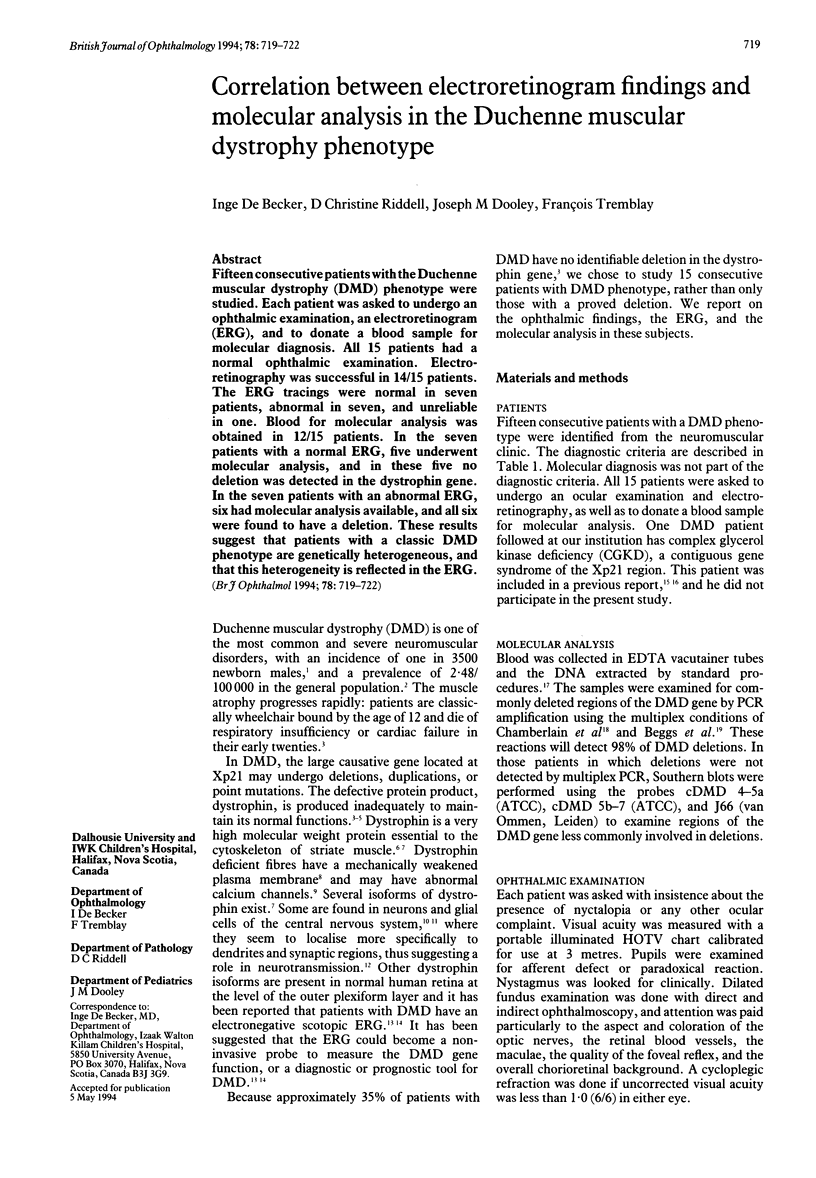Abstract
Fifteen consecutive patients with the Duchenne muscular dystrophy (DMD) phenotype were studied. Each patient was asked to undergo an ophthalmic examination, an electroretinogram (ERG), and to donate a blood sample for molecular diagnosis. All 15 patients had a normal ophthalmic examination. Electroretinography was successful in 14/15 patients. The ERG tracings were normal in seven patients, abnormal in seven, and unreliable in one. Blood for molecular analysis was obtained in 12/15 patients. In the seven patients with a normal ERG, five underwent molecular analysis, and in these five no deletion was detected in the dystrophin gene. In the seven patients with an abnormal ERG, six had molecular analysis available, and all six were found to have a deletion. These results suggest that patients with a classic DMD phenotype are genetically heterogeneous, and that this heterogeneity is reflected in the ERG.
Full text
PDF



Selected References
These references are in PubMed. This may not be the complete list of references from this article.
- Ahn A. H., Kunkel L. M. The structural and functional diversity of dystrophin. Nat Genet. 1993 Apr;3(4):283–291. doi: 10.1038/ng0493-283. [DOI] [PubMed] [Google Scholar]
- Beggs A. H., Koenig M., Boyce F. M., Kunkel L. M. Detection of 98% of DMD/BMD gene deletions by polymerase chain reaction. Hum Genet. 1990 Nov;86(1):45–48. doi: 10.1007/BF00205170. [DOI] [PubMed] [Google Scholar]
- Boyce F. M., Beggs A. H., Feener C., Kunkel L. M. Dystrophin is transcribed in brain from a distant upstream promoter. Proc Natl Acad Sci U S A. 1991 Feb 15;88(4):1276–1280. doi: 10.1073/pnas.88.4.1276. [DOI] [PMC free article] [PubMed] [Google Scholar]
- Bushby K. M. Genetic and clinical correlations of Xp21 muscular dystrophy. J Inherit Metab Dis. 1992;15(4):551–564. doi: 10.1007/BF01799614. [DOI] [PubMed] [Google Scholar]
- Chelly J., Hamard G., Koulakoff A., Kaplan J. C., Kahn A., Berwald-Netter Y. Dystrophin gene transcribed from different promoters in neuronal and glial cells. Nature. 1990 Mar 1;344(6261):64–65. doi: 10.1038/344064a0. [DOI] [PubMed] [Google Scholar]
- Cibis G. W., Fitzgerald K. M., Harris D. J., Rothberg P. G., Rupani M. The effects of dystrophin gene mutations on the ERG in mice and humans. Invest Ophthalmol Vis Sci. 1993 Dec;34(13):3646–3652. [PubMed] [Google Scholar]
- Franco A., Jr, Lansman J. B. Calcium entry through stretch-inactivated ion channels in mdx myotubes. Nature. 1990 Apr 12;344(6267):670–673. doi: 10.1038/344670a0. [DOI] [PubMed] [Google Scholar]
- Gardner-Medwin D., Sharples P. Some studies of the Duchenne and autosomal recessive types of muscular dystrophy. Brain Dev. 1989;11(2):91–97. doi: 10.1016/s0387-7604(89)80075-0. [DOI] [PubMed] [Google Scholar]
- Koenig M., Beggs A. H., Moyer M., Scherpf S., Heindrich K., Bettecken T., Meng G., Müller C. R., Lindlöf M., Kaariainen H. The molecular basis for Duchenne versus Becker muscular dystrophy: correlation of severity with type of deletion. Am J Hum Genet. 1989 Oct;45(4):498–506. [PMC free article] [PubMed] [Google Scholar]
- Lidov H. G., Byers T. J., Watkins S. C., Kunkel L. M. Localization of dystrophin to postsynaptic regions of central nervous system cortical neurons. Nature. 1990 Dec 20;348(6303):725–728. doi: 10.1038/348725a0. [DOI] [PubMed] [Google Scholar]
- Love D. R., Hill D. F., Dickson G., Spurr N. K., Byth B. C., Marsden R. F., Walsh F. S., Edwards Y. H., Davies K. E. An autosomal transcript in skeletal muscle with homology to dystrophin. Nature. 1989 May 4;339(6219):55–58. doi: 10.1038/339055a0. [DOI] [PubMed] [Google Scholar]
- Matsumura K., Tomé F. M., Collin H., Azibi K., Chaouch M., Kaplan J. C., Fardeau M., Campbell K. P. Deficiency of the 50K dystrophin-associated glycoprotein in severe childhood autosomal recessive muscular dystrophy. Nature. 1992 Sep 24;359(6393):320–322. doi: 10.1038/359320a0. [DOI] [PubMed] [Google Scholar]
- Miller S. A., Dykes D. D., Polesky H. F. A simple salting out procedure for extracting DNA from human nucleated cells. Nucleic Acids Res. 1988 Feb 11;16(3):1215–1215. doi: 10.1093/nar/16.3.1215. [DOI] [PMC free article] [PubMed] [Google Scholar]
- Pillers D. A., Bulman D. E., Weleber R. G., Sigesmund D. A., Musarella M. A., Powell B. R., Murphey W. H., Westall C., Panton C., Becker L. E. Dystrophin expression in the human retina is required for normal function as defined by electroretinography. Nat Genet. 1993 May;4(1):82–86. doi: 10.1038/ng0593-82. [DOI] [PubMed] [Google Scholar]
- Pillers D. A., Seltzer W. K., Powell B. R., Ray P. N., Tremblay F., La Roche G. R., Lewis R. A., McCabe E. R., Eriksson A. W., Weleber R. G. Negative-configuration electroretinogram in Oregon eye disease. Consistent phenotype in Xp21 deletion syndrome. Arch Ophthalmol. 1993 Nov;111(11):1558–1563. doi: 10.1001/archopht.1993.01090110124037. [DOI] [PubMed] [Google Scholar]
- Standard for clinical electroretinography. International Standardization Committee. Arch Ophthalmol. 1989 Jun;107(6):816–819. doi: 10.1001/archopht.1989.01070010838024. [DOI] [PubMed] [Google Scholar]
- Tinsley J. M., Blake D. J., Roche A., Fairbrother U., Riss J., Byth B. C., Knight A. E., Kendrick-Jones J., Suthers G. K., Love D. R. Primary structure of dystrophin-related protein. Nature. 1992 Dec 10;360(6404):591–593. doi: 10.1038/360591a0. [DOI] [PubMed] [Google Scholar]
- Tremblay F., LaRoche R. G., Shea S. E., Ludman M. D. Longitudinal study of the early electroretinographic changes in Alström's syndrome. Am J Ophthalmol. 1993 May 15;115(5):657–665. doi: 10.1016/s0002-9394(14)71466-7. [DOI] [PubMed] [Google Scholar]
- Weleber R. G., Pillers D. A., Powell B. R., Hanna C. E., Magenis R. E., Buist N. R. Aland Island eye disease (Forsius-Eriksson syndrome) associated with contiguous deletion syndrome at Xp21. Similarity to incomplete congenital stationary night blindness. Arch Ophthalmol. 1989 Aug;107(8):1170–1179. doi: 10.1001/archopht.1989.01070020236032. [DOI] [PubMed] [Google Scholar]
- Worton R. G. Duchenne muscular dystrophy: gene and gene product; mechanism of mutation in the gene. J Inherit Metab Dis. 1992;15(4):539–550. doi: 10.1007/BF01799613. [DOI] [PubMed] [Google Scholar]
- Worton R. G., Thompson M. W. Genetics of Duchenne muscular dystrophy. Annu Rev Genet. 1988;22:601–629. doi: 10.1146/annurev.ge.22.120188.003125. [DOI] [PubMed] [Google Scholar]
- Zubrzycka-Gaarn E. E., Bulman D. E., Karpati G., Burghes A. H., Belfall B., Klamut H. J., Talbot J., Hodges R. S., Ray P. N., Worton R. G. The Duchenne muscular dystrophy gene product is localized in sarcolemma of human skeletal muscle. Nature. 1988 Jun 2;333(6172):466–469. doi: 10.1038/333466a0. [DOI] [PubMed] [Google Scholar]


